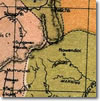
Pastoral Station entry
| Home | Browse | Search | Previous | Next |

|
Unlocking Regional Memory
Pastoral Station entry
|
|
Bald Blair Station (1872 - ) |
||
|
||
| Location: Guyra, New South Wales, Australia | ||
The Bald Blair Station is situated east of Guyra, NSW. Purchased in 1872 by Francis J. White, the station was extensively developed after 1906 by his son, Harold. Once reputed to be known as a place, "...too rotten to own..." Blair Bald became one of the finest stations in the region. |
Details | |
|
Bald Blair Station, situated about 12 kilometres east of Guyra on the New England tablelands, was practically virgin land until the Whites of Samaurez, near Armidale, purchased it from J Coventry in 1898. The paternal head of this well-known pastoral family, Francis John White, had been offered the estate on various occasions, but, according to his son, Harold, had refused the property on the grounds that it was ‘too rotten to own’. When Francis White died in 1874, his two eldest sons, FJ and James, formed a company called White Brothers and began buying up surrounding properties. One of these was Bald Blair Station. The property lay virtually dormant until 1906, when Harold White returned from Sydney to manage the family’s Guyra properties , Ward’s Mistake, Aberfoyle and Bald Blair. From his selection at Ward’s Mistake, White began to make plans for the development of Bald Blair Station. The land, as his father had cautioned, was in a poor state; it was frequently flooded and thus provided ideal conditions for the outbreak of diseases such as liver fluke and footrot. Harold White’s first task, then, was to drain the land by horse and plough, and later still, by tractor and bulldozer. Literally hundreds of kilometres of open drain were cut on the property during the early years of the twentieth century. A firm advocate of pasture improvement, White also introduced English grasses to the property and was one of the first New England graziers to make use of superphosphate. In a short period, Bald Blair Station was transformed from a run capable of carrying not one but four sheep per acre. White also bred black Angus cattle, an initiative which brought considerable recognition for Bald Blair. By 1926, the herd had won ten championships, forty-two first prizes and twenty-six second prizes at the Sydney and Brisbane Royal Shows. The same year, White’s Bald Blair Earl the Fourth took out the Supreme Championship at the Sydney Show. A homestead was commenced in 1911, after Harold had married Evelyn Augusta Curtis of Brooklyn, Armidale. Built of Armidale brick and local timber, the house was situated on the bare ridge overlooking Baldblair Creek. With its carefully-manicured gardens, spacious interior and ‘rich yet comfortable atmosphere’, the homestead was typical of those inhabited by New England’s well-to-do graziers. Like many of the region’s properties, Bald Blair Station was gradually reduced during the first half of the twentieth century. Curiously, Harold White was a strong believer in the principle of closer settlement, and after World War One the family voluntarily forfeited large areas of leasehold land. In 1926, some 34,000 acres of the Bald Blair estate (then including its subsidiary interests at Aberfoyle, Ward’s Mistake, Green Hills and Cook’s Creek) was subdivided. The property, described by one agent as ‘most fertile’, ‘marvellously productive’ and ‘practically free of any rough or inferior country’, sold quickly, leaving Harold and Evelyn White with Bald Blair itself. The run, originally covering an area of about 20,000 acres, was reduced to 5,200 acres. Nevertheless, White’s successful efforts to improve the land over the years meant that the carrying capacity of Bald Blair remained solid. By the 1950s, the property still ran 6,000 ewes and 500 Angus cows. In 1971, Harold White died at the age of eighty-eight. He was survived by Evelyn, two sons and two daughters. The eldest son, Richard, took charge of Bald Blair and has since further developed the Angus stud program introduced by his father. Related Bodies:
| |
| |
Controlling Corporate BodiesOwned by | |
| Top of Page | |
|
|
| ||
|
Published by The Australian Science and Technology Heritage Centre, 5 April 2004 Prepared by: Acknowledgements Updated: 23 February 2010 http://www.nswera.net.au/biogs/UNE0043b.htm |